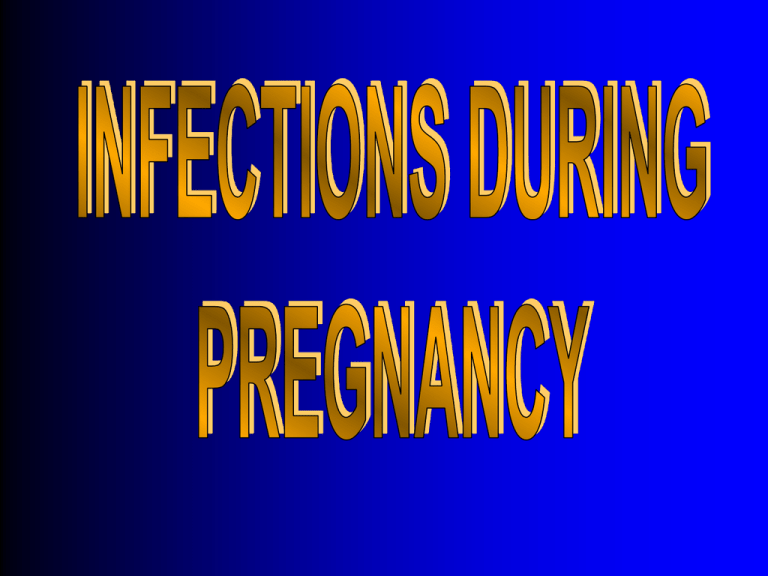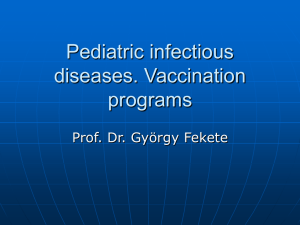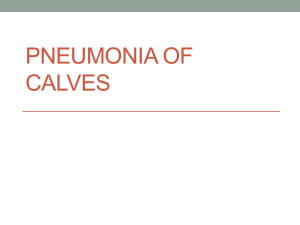
Perinatal infections account for 2% - 3% of
birth defects which arise form a spectrum of
organisms & have varying modes of
transmission .
Not all birth defects are routinely screened
for during prenatal care, but all birth defects
do pose a risk to the fetus or neonate .
The variation in residual status of the
mother after primary infection should be
noticed .
Caesarian section delivery is
recommended only for mothers who have
active genital lesions at the time of delivery.
mostly viral
previously known as ( TORCH)
infections: Toxoplasmosis, Other(
syphilis), Rubella, CMV, Herpes( and
Hepatitis), the first four are acquired
antenately, herpes and hepatitis usually
perinately.
The term TORCH is now obsolete as
other agents are important ( e.g. HIV).
Most fetuses if infected during the first
trimester will suffer from a syndrome of
congenital malformation.
RUBELLA: ( German Measles).
The fetus is most at risk in the first 16 weeks
gestation.
Causative Organism: Rubella virus ( togaviruses
RNA).
Route of Infection : via respiration as the virus is
concentrated in the nasopharyngeal secretions.
Incubation Period: 14-21 days.
Symptoms: Mild pyrexia, arthralgia, rash which
persists for a week and always affecting the face,
lymphadenopathy in the postauricular, deep cervical
and suboccipital L.N. precedes the appearance of
the rash and persists for 3 weeks.
Risk of fetal transmission:
-50-60% of fetuses are affected if maternal primary
infection is in the first month of gestation.
-22% in the second month, 6-10% in the third to
fourth month.
Risk of Fetal infection %
Gestational age in weeks
Fetal infection %
< 11
11-12
13-14
15-16
> 16
90 %
30 %
20 %
10 %
5%
Despite of availability of effective vaccines up
to 20% of women of child bearing age don’t
possess rubella antibody.
The congenital rubella syndrome includes:
a-Neuropathic changes:
1.microcephaly.
2.mental& motor retardation.
3.meningoencephalitis
4.cerebral palsy.
5.cerebral calcification
b-Cardiovascular lesions:
1.persistent ducats arteiosis
2.pulmonary artery stenosis
3.atrioventricular septal defects
c-Ocular defects:
1.cataract
2.microphthalmia
3.retinal changes, retinitis
4.blindness
The congenital rubella syndrome
includes:
d- Inner ear problems
1.sensorineural
e- Symmetric intrauterine growth
retardation.
F- Other:
1.purpura
2.jaundice
3.hepatosplenomegaly
4.thrombocytopenia
Routine antenatal screening:
vaccination
( avoid pregnancy for 3 months).
Maternal screening: routine rubella IgG
in the first trimester, if infection
suspected perform rubella IgM.
Prevention:
- vaccination before or after pregnancy
( not during).
- in acute infection: droplet precautions.
- in neonatal infection: contact
precautions.
CYTOMEGALOVIRUS (CMV)
in UK CMV is commoner cause of cong.
Retardations than rubella.
Infects 50%to 60% of women of
childbearing age.
Causative agent: CMV (Herpes virus
DNA).
Maternal symptoms : usually mild or
asymptomatic, fever with/without
lymphadenopathy, sore throat.
Transmission:
direct: person to person contact ( saliva, milk,
urine, semen, tears, stools, blood, cervical and
vag. Secretion.).
indirect: contaminated fomites.
in primary CMV infection , 30-40% of fetuses
will be infected, 2-4% of them will develop
severe malformations at birth.
in recurrent CMV infections ( about 1% of
fetuses will be infected and the rest will appear
normal at birth, but later in life, they may suffer
from delayed speech and learning difficulties
due to cerebral calcification and sensorineural
hearing loss. And small group will have
chorioretinitis.
Complications of fetal CMV infection
include:
1. micro-& hydrocephaly
2. chorioretinitis
3. cerebral calcification
4. mental retardation
5. heart block
6. petechiae
Maternal screening: not recommended.
Prevention: hand washing( especially
after changing diapers).
TOXOPLASMOSIS
Causative agent: by protozoan toxoplasma
gondi.
Risk of fetal infection:
First Trimester - 15 % ( less incidence of fetal
infection but serious disease is most common ).
Second Trimester - 25 % .
Third Trimester - 65 % ( but almost 90% of
newborns are without clinical signs of disease ).
40% of fetuses are affected if the mother has the
illness.
the earlier in pregnancy the more damage.
Maternal symptoms: usually asymptomatic,
fever, rash & eosinophelia If symptomatic ( the
CNS prognosis is poor).
Maternal screening: not recommended,
if infection suspected( toxoplasma IgG,
IgM, and repeat test every 10 weeks
through pregnancy.
Treatment: start spiramycin in infected
mothers to reduce transmission to the
fetus.
Prevention: wash hands before eating,
after handling raw meat , after contact
with cat feces, & soil & cook their meat
adequately.
Infection in the pregnancy may result in:
(occur only if there is acute exacerbation
during pregnancy):
1.spontaneous abortion.
2.perinatal death.
3.abnormal growth.
4.characteristic triad of fetal anomalies:
a- Chorioretinitis .
b- Hydrocephaly or microcephaly.
c- Cerebral calcification .
Human Immunodeficiency
Virus (HIV)
Causative agent: RNA retrovirus.
Fetal transmission : is 25% if the
mother is infected, reduced to 8% in
if the mother is treated with
zidovudine and less than 3% with
suppressive triple antiretroviral
therapy.
Transmission during pregnancy and
Puerperium: majority of infants infected in third
trimester or at time of delivery ,vertical
transmission can occur during vaginal delivery , so
caesarean section is protective
(up to 50%).
premature babies are more at risk of vertical
transmission.
transmission may also occur with breastfeeding.
bottle feeding reduces vertical transmission
possibly by up to 50%.
Screening: Routine HIV antibody performed in 1st
trimester). Repeat in 3rd trimester if high risk for
HIV.
Serology: IgG & IgM antibodies (false +ve in
1.6%).
If HIV positive, consult Infectious Diseases ,and
avoid breastfeeding.
transferred maternal antibody persists up to 18
months in uninfected infants, so gene amplification
via polymerase chain reaction can detect neonatal
HIV infection.
intrauterine HIV is associated with prematurity and
growth retardation.
Clinical problems :appear sooner in infected
baby than in adult AIDS (e.g. at aged 6
month)
with:
- hepatosplenomegaly - failure to thrive encephalopathy - recurrent fever respiratory
diseases (interstitial lymphocytic
pneumonitis) - septicemia (salmonella) pneumocystis
- lymphadenopathy.
Death is usually from respiratory failure or
overwhelming infection( 20% at 18 months).
VIRAL HIBATITIS
Most common cause of jaundice during
pregnancy.
HepatitisB transmitted by contaminated
blood ,saliva, breast milk, semen .
Hepatitis B
DNA virus
Complications: may cause Hepatitis ,Cirrhosis and/or liver
cancer (as an adult at age of 30- 40 years)·
Rate of transmission from mother to fetus :10-20% (if
HBeAg positive -90%)
Pregnant women who are infected transmit the virus
transplacentally to the fetus and at birth.
Neonatal jaundice :is rare in women with chronic hepatitis or
acquired hepatitis early in pregnancy.
The risk is high when infection occurs late in pregnancy.
Screening: Routine HBsAg (performed in 1st trimester).
Prevention: HBIG (Hepatitis B immune globulin) and HBV
vaccine should be given to baby at birth.
If non-immune mother exposed in pregnancy give HBIG and
HBV vaccine.
Hepatitis C
RNA Virus
Vertical transmission is low with rate of
approximately 6%.
The risk of transmission correlates with HCV viral
titer in the mother .
Complications: Hepatitis, Cirrhosis and/or liver
cancer (as an adult).
Screening: HCV-A B recommended in high risk
pregnant patients:
-intravenous drug users ( IVDU ).
-blood transfusion before 1995
-undiagnosed hepatitis.
Prevention: Avoid high risk behavior ,e.g. IVDU
currently no post-exposure prophylaxis available.
Herpes Simplex (Primary or
Recurrent).
herpes virus family, DNA virus.
Primary
· Fetal loss
· Congenital Syndrome
Recurrent
· Mucocutaneous lesions
· Disseminated disease
· Encephalitis
Transmission occurs at time of delivery in 9095% of cases( vaginal delivery).
Neonatal HSV infection affects 1/5000 births (half
of these related to primary infection).
*Prevention:If lesions present at time of delivery,
recommend caesarean section.
- Daily oral acyclovir can be considered in late third
trimester.
Varicella Zoster
Herpes virus family, DNA virus.
If infection occurs in first trimester
4.9% risk of congenital varicella .
Congenital Syndrome
-Limb hypoplasia
-Ocular abnormalities
-CNS abnormalities ( convulsive
disorders ).
-Dermatomal scarring
If infections aquired in the last 10
days of pregnancy result in variably
sever fetal infections with neonatal
mortality as high as 34% .
Perinatal period (neonatal varicella)
-Chicken pox
-Encephalitis
20-40% risk of (neonatal varicella)
infection if mother develops
varicella in peripartum period.
Serology (IgG and IgM).
Screening: Routine screening
generally not recommended.
Prevention: If pregnant woman
(with no history of previous
chickenpox) is exposed, perform
STAT Varicella IgG.
Exposed neonate should receive
VZIG prophylaxis.
SYPHILIS
Effect of Syphilis on Pregnancy:
The more is the duration between infection and
conception, the less is the foetal affection.
Abortion: of a dead foetus after the 4th
month of pregnancy when the spirochetes
can cross the placenta as the cytotrophoblast
starts to disappear.
Repeated late abortions then premature or
mature macerated still born then live born
with congenital syphilis or developing it
later on.
congenital syphilis:-Skin eruption- osteititis
of nasal bones – saddle nose –
hepatosplenomegaly-frontal bossing -8th
nerve deafness.
Effect of Pregnancy on Syphilis
Primary lesion which is the sign of early
syphilis may be masked if infection
occurs during pregnancy.
Causative agent: Treponema Pallidum
Mode of transmission:
-sexual ( most common).
-close contact with open lesions( rare).
-direct blood transfusion.
-cong. Syphilis
Fetal infection is most likely when the
mother is in the primary or secondary
stages.
Diagnosis
(A) History: of infection, repeated late abortions or macerated
still birth.
(B) Examination: Signs of primary, secondary or tertiary
syphilis.
(C) Investigations: by serological tests;
(I) Non- specific (non-treponemal ) tests:
Venereal disease research laboratory (VDRL).
Rapid plasma reagin (RPR).
(B) Specific (treponemal) tests:
Fluorescent treponemal antibody absorption test (FTA - ABS).
Treponema pallidum immobilization test (TPI).
Non-treponemal test can be positive in other conditions as
collagen diseases , lymphomas, mononucleosis, and
febrile illnesses. So these tests can be performed as
screening tests, if positive a specific (treponemal) test is
done to confirm or refute syphilis.
Treatment
(A) Mother:
Treatment should be started before 16 weeks i.e.
before spirochetes cross the placenta
(I) Penicillin:
Procaine penicillin 600.000 units IM daily for 17
days or - benzathine penicillin (long acting) 2.4
million units IM, half the dose in each buttock.
This is repeated for 3 courses at 2 weeks
interval.
(II) Erythromycin:
500 mg/ 6 hours orally for 21 days is given to
patients who are allergic to penicillin.
(B) New born:
Procaine penicillin 150.000 units IM for 10 days.
GONORRHEA
Causative agent: Neisseria
gonorrhoeae ( gram -ve diplococci).
Symptoms: usually asymptomatic.
Mucopurulent endocervical discharge,
dysuria, proctitis.
may cause perihepatitis ( Fitz -HughCurtis syndrome).
In infants: it infects conjunctiva
(gonococcal ophthalmia neonatorum,
prevented by 1% silver nitrate eye
drops immediately after birth),
pharynx, respiratory tract, or anal
canal.
Diagnosis:
gram stain of urethral or endocervical
exudates ( intracellular diplococci).
Culture.
Treatment:
in pregnancy:
Ceftriaxone single i.m. dose.(Rocephine
1 gm I.v-I.m)
Or
Spectinomycin 2 gm single i.m. dose +
erythromycin 500mg qds/7d.
infants:
Benzyl penicillin 30mg/kg stat. (
cephalosporin) + chloramphenicol eye
drops.
CHLAMYDIA TRACHOMATIS
Associated with: low birth weight, premature
rupture of membrane, fetal death.
Conjunctivitis in 5-14 days after birth.
Complication: Chlamydia pneumonitis,
pharyngitis,otitis media.
Treatment:
infant: 1% tetracycline oint, Or drops +
erythromycin 10 mg/kg qds PO for 3 weeks.
Parents: erythromycin PO
During pregnancy: erythromycin is used, but
Amoxicillin 500mg/8h PO for 1 week is better
tolerated
Streptococcal infections
Group A & B Beta-hemolytic
Streptococci:
Are the major causes of perinatal infection .
Group B Streptococci which is a normal
constituent of Genital tract in 5 to 25% of
pregnant women has become the most
common cause of perinatal infection.
Diagnosis: St. infection is suspected in
patients with primaturely ruptured
membranes, septic abortion, endometirtis,
chorioamnionitis, or pelvic peritonitis.
The diagnosis is established by culturing
group A or B St. from genital exudates or
blood .
Life threatening: Puerperal infections
occur on occasion in group B St. infections
particularly in women with prolonged
rupture of membranes, stillbirths & septic
abortions are infrequent complication.
25% of infants: Born to mothers harboring
Beta St. complicated with neonatal sepsis
including meningitis & Pneumonia.
Penicillin or ampicillin is Drug of choice.
Dr.Essam. S. Abushwereb
Consultant Gynaecology & obstetrics
2010








